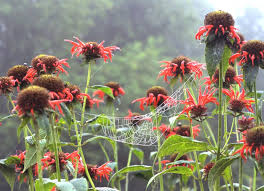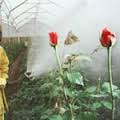The Gillette Forum: My Reframed Beauty
by Jonah Holland, PR & Marketing Coordinator, Lewis Ginter Botanical Garden
I came away from the Gillette Forum completely in awe of the job that landscape architects who are committed to creating beautiful but sustainable landscapes have. The task of convincing those with the power (the client) to do the right thing environmentally, seems daunting — especially if the client thinks they know what they want or that they think they know what is beautiful. After listening to Thomas Woltz, ASLA, and Douglas Reed, FASLA, Lewis Ginter’s Gillette Forum keynote speakers, I realized that beauty is subjective and that the key to successful collaborations between clients and landscape architects is education. Something that seems daunting, is all of a sudden simple when one realizes how convincing the simple truth can be. Plus, lucky for us, we had two of the most inspiring and influential sustainably-minded landscape architects here to educate us. All of a sudden when we realize what we thought was beautiful (a perfect rose, rolling emerald green hills of grazing land, a house on the very top of a knoll) has unwanted ecological effects, suddenly what seemed beautiful one moment, is no longer beautiful. Woltz and Reed helped us question a few assumptions.
For me, the issue is illustrated very beautifully in a simple example by Thomas Woltz, ASLA, of Nelson Byrd Woltz Landscape Architects. He gave us a chilling example of the life that a factory produced rose lives. I’ve never been a fan of store-bought roses. Somehow they seem too perfect. But Woltz shared with us exactly how imperfect they are — raised in a clinical environment filled with cancer-causing pesticides, where they never stick their feet in the tepid soil or experience a breeze through their leaves or petals. I’ve never really felt sorry for a plant before — but my heart strings were pulled for these roses that are not ever even allowed to bloom with a sleeve placed over their budding petals to prevent it.
In stark contrast, a leggy monarda or bee balm flower hangs in the dew with its brothers and sisters strung together with a creepy dew-covered spiderweb. These lightly petaled flowers, seem a bit scrappy until you take a second glance — until you compare them to the Ecuadorian roses grown at a fumigated indoor facility. I’ll let Woltz tell you about it:
“I want to start by talking about questioning a few assumptions….so a rose — growing up, I always thought a rose was beautiful, and…..The more you know about where things come from — and I think it is our duty inform ourselves at this point — you start to question things that you always thought were beautiful. This is where that rose was grown. In Ecuador, at an indoor facility that is fumigated. Its a completely pesticide-ridden environment. The roses even aren’t allowed to bloom naturally they are just in this little sock, so that they will be the perfect shape. ….And then there are the health ramifications of these people working in these factories unprotected from pesticides and the rates of cancers, and of tumors of internal organs is skyrocketing. So understanding where what we consume comes from I think is our duty as modern citizens today. And so I takes what i might have always though of as a beautiful bouquet and it makes me think, ‘I would never give that to my wife or to my mother.’ You know that is someone I love, so why would I give something with these origins away? (and then he shows us the slide of the Mondarda) …..
and, this … becomes the bouquet that I start to have an affection for — a funny looking Monarda didyma that I just love …and you can see there is a beautiful spiderweb hung with dew and think that is the bouquet that I want to talk about. That is the beauty I want to find in the world that we inhabit. ….I would never give this (Ecuadorian rose bouquet) to my wife or to my mother.”
Woltz also mentioned an article by Elizabeth Meyers called “Sustaining Beauty” that discusses this very topic. How we have a psychological need for things that are beautiful, but that there is power in having it be sustainable.
He told us something that I never knew — that New Zealand (a place that now looks somewhat like Ireland with rolling green hills) was once all rain forest. Those emerald green grazing hills are very beautiful…..or are they? I didn’t know that New Zealand had no mammals on it until humans imported them (first rats, then dogs, then animals to try to control the rats) and that the ecosystem of birds and reptiles in rain forest land was completely wrecked because they had evolved making nests on the ground with no protection. Woltz is now working on setting that straight, by taking on one of the largest private ecological restoration projects ever, and creating a mammel-free zone on the tip of a peninsula dedicated to preserving those New Zealand birds and reptiles who are on the edge of extinction.
Woltz’s work continues to influence Virginia, the area surrounding his office in Charlottesville in particular. And thankfully, “keeping up with the Joneses” can have its benefits. One neighbor is convinced to make a change toward sustainable architecture and then suddenly there is a bandwagon effect. The amazing thing is how easily neighbors and citizens can be convinced to spend a bit more money to create a more elaborate project in order to help nature. We heard example after example of people who after experiencing the beauty and resurgence of nature of their neighbors estates hired Woltz’s firm saying, whatever you did over there, that is what I want.
For me, I’ve told my husband, I never want another store-bought rose again. But not only that, I’m trying to remember this story in every facet of my life. What you think you want, you may not want — whether it is a perfect, blemish-free apple, or a green, dandelion-free yard. And the beauty of it is, what you think of as beautiful can change. And maybe, as we fall in love with our Mondarda, we will fall in love with our own beautiful and quirky imperfection as well.
Photo credit: http://www.motherjones.com/politics/2002/01/deflowering-ecuador

